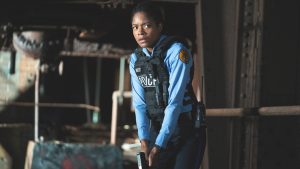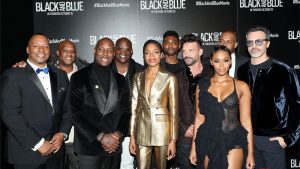90 Black And Blue (2019)
Black And Blue (2019): An Issue with Race and the Police
By Kacey Dickman
Growing up in a middle-class white home, I never had to look over my shoulder in worry of police brutality. In fact, the phrase “police brutality” was not in my vocabulary until adulthood. For this final assignment, I chose the 2019 thriller Black And Blue directed by Deon Taylor. This film is very fitting in light of recent tragic events. I hope I can do justice in my words to what has recently happened as I break down this thought-provoking film. The storyline and themes of this film were very methodically planted throughout the film, designed to open one’s eyes to current issues, such as racism and corrupt police, that our nation is facing.
Black And Blue is set in New Orleans in 2019 when Alicia West (Naomi Harris) returns to her hometown after her deployment in the US Military. She grew up in the lower socio-economic class neighborhoods part of New Orleans. Alicia grew up surrounded by gangs and drug dealing. To better herself, she made a life in the military which gave her a sense of duty. So as she returns home, she joins the New Orleans Police Department. As a young African-American woman, she faces racial issues inside and outside of her job. The brief summary of the film features Alicia West taking on an extra shift with a senior officer. They take a drug-related call to the rougher parts of town. She is told to stay put in the police car, but when she hears shots fired, she investigates. As she finds her temporary partner in a group with Narcotic Officers who had just executed young drug dealers, they see her. One Narc shoots at her and she escapes. They realize she has a body camera on, and pursue her in order to destroy the evidence of their crimes. The narcotic officers who shot the young drug dealers and Alicia tell the local gang leader that she was the one that killed his dealers. This sets up a hunt for her with the local gang and the police station.

Back to scenes that deal with race and social class, the start of the film begins with Alicia running in a higher income neighborhood and is pulled over by two middle-aged white cops. They immediately got aggressive with her when she was being compliant and tried to tell them that it was her neighborhood she was running in. She even tells them that she is “blue” referencing herself as being a police officer. Until they find her wallet and badge, they release her and apologize. This unnecessary use of force happens all the time with officers and those in the black community. According to Clarence Edwards, “Police officers from each of the aforementioned groups sometimes bring negative attitudes and or stereotypes to these communities that can adversely affect their decisions and the fairness of their enforcement actions” (Edwards). After realization, they tried to play off that it wasn’t about race and they were looking for someone “matching her description.” They obviously targeted her because she was a black woman running in a high-income neighborhood. This was an act of direct stereotyping her with racism and classism.
As described previously, the two male officers used their badge to force a person into submission. That person was Alicia West, a fellow police officer. It wasn’t until they saw her ID and realized she was one of them that they stopped harassing her. Even though before seeing her identification, she tried to tell the male officers of her affiliation, they kept handling her with unnecessary aggression. This abuse of power is used every day in real life on African-American civilians, but not all of them are as fortunate as Alicia was in Black And Blue.
This film has so many subtle hints and metaphors with the use of eyes. I believe this theme of cinematography was used to get to the viewers. One scene cuts to the span of the city, specifically on an abandoned building, graffitied with “Open Your Eyes” along the base of the building. This was such a subtle yet loud smack in the face to the viewers watching this film early on. Other instances with eyes towards the end of the film. As Alicia fights for her life against the narc officer who put a bounty on her head with the gangs, the film cuts to many different graffiti paintings of eyes on the inner courtyard of where the fight was taking place. I believe this is a way for the movie to speak to the viewers that a silent witness helps no one. If no one says anything, the corrupt get away with their abuse of power.
The attention to detail from the writers and director with the issues of racism and classism are very in-depth. With the subtle use of eyes, to the beginning of the film with Alicia’s instance with the white officers. The writers made sure to include as many aspects of the social issues that African-Americans face with corrupt police officers. As previously discussed, direct racism is described by the white officers’ abuse of power when pulling Alicia over from her run. More indirect incidents just barely hint at racism and exclusion towards Alicia West. One scene shows the locker room with all the official placards with the officers’ names on the lockers, but Alicia has one made out of white tape and a black marker. Yes, she is new to the department, but they knew they hired her and it would not be hard to have an official one made for her. Her status as a rookie is why she is sent on a double shift, and ultimately leading up to the whole storyline of her witnessing an illegal execution and so forth.
There is one huge unconventional issue with race that this movie addresses, civilian African-Americans views on African-American police officers. Alicia West grew up in the “ghetto” as described in the film. She used to be a part of the police fearing group. Due to her leaving her past behind, joining the military, and ultimately joining the Police Force, she is seen as a “traitor” to her old “friends.” This complicates how a person of color in law enforcement may interact with people of their own race. According to Carbado and Richardson, “The central question we ask is: What are the dynamics that might shape how African American police officers police other African Americans? Asked another way, what do existing theories about race and race relations, and historical and empirical studies on race and policing, suggest about how African Americans will police our own?” (Carbado & Richardson) Early in the film Alicia and her partner stop at a convenience store to get snacks, Alicia sees a young boy playing with his skateboard. When she tries to strike a conversation with him, he gets defensive about the ownership of the skateboard, and his mother quickly scolds him for talking to an officer. Alicia tries to de-escalate the situation, but the mom wants to part in any conversation with an officer. Alicia starts to recognize the woman as an old best friend, but the woman coldly rejects her by saying she doesn’t know her. A hidden meaning was implied with her statement, that she doesn’t know Alicia as “cop Alicia.” Even though Alicia West grew up with her and would obviously recognize an old friend, because she is now a cop, she is no longer considered a friend.
In the movie, Alicia tries to make a point that one is not “black or blue” that you can be both… hence the name Black And Blue. As A. O. Scott describes in the NYtimes, “the neglect and corruption that followed — are still evident, and the alienation of poor, black citizens is painful and profound. Alicia wants to believe something else is possible, that common ground exists, that people don’t have to be classified as ‘allies or enemies’.” (Scott, A.) The long bloody history of police officers and the African-American community has alienated African-American police officers from their fellow brothers and sisters at home and vice versa. I feel like this film is trying to humanize each end. The casting of this film also helped bring these issues to life. Naomi Harris’s performance is brilliant. This movie goes past just being an entertaining thriller. But subtly deals with racial issues within and without the police community. I think this film can unify those who stand on both points of view of police brutality.

I have personally seen this movie a few times. Mostly for entertainment purposes, but also got the message from the film each time. When I watched the movie with my roommates, my one roommate was actually the one to point out all the subtle innuendos with the eyes. That point of view really hit me hard in understanding the entire point of the film. The audience itself needs to wake up to the issues of race and the police. This film would definitely not work or resonate deep with the audience if it was performed by a white actress. There was no white-washing nor was there any downplaying on the social issues that are wrong with America right now.
In all honesty, I almost picked the movie Blackkklansman, but Black And Blue deals more directly with today’s issues within the police force. The movie is up to date with more current issues at hand, especially now more than ever. I picked this movie out of all the others because it isn’t super alt-left or alt-right. It can’t really offend anyone, and it portrays real issues so accurately and blatantly. There is no way of defending either end of corruption in the police community or in the low-income African-American community. Drug dealing and gang life are wrong, but so is corruption and disregard for life in the police force. When Milo, a character in Black And Blue, questions why Alicia doesn’t just cave in and surrender, she goes to tell him that, “A person is a person, and a murder is a murder. It doesn’t matter who you are.” Which is so true. This moment humanizes both the badge and the black community. This film is also entertaining, so it doesn’t cause a person to feel like a message is being preached to them. Much like in chapter 3 of America On Film discusses Classical Hollywood Narrative Form.
I may not know the struggle that the African-American community faces with the Police community, but I can try to understand and listen. Especially with current events happening right now, the black community needs unity from all walks of life right now. I hope that this film can be seen by others, and help them understand the social issue at hand in America. Issues with race, social class, sexuality, gender, etc… The more we as the people try to understand each other, the better our country will become.
References
Benshoff, H. and Griffin, S., 2011. America On Film: Representing Race, Gender, and Sexuality in the Movies. Malden, MA: Wiley-Blackwell.
Clarence Edwards. Race and the Police. (2016, February 18). Retrieved May 25, 2020, from https://www.policefoundation.org/race-and-the-police/
Scott, A. (2019, October 24). ‘Black and Blue’ Review: A Cop Thriller for Our Age of Dread. Retrieved June 01, 2020, from https://www.nytimes.com/2019/10/24/movies/black-and-blue-review.html
Carbado, D., & Richardson, L. (2018, May 10). The Black Police: Policing Our Own. Retrieved May 25, 2020, from https://harvardlawreview.org/2018/05/the-black-police-policing-our-own/

